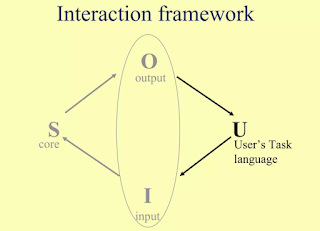he Norman model of interaction, often referred to as the "seven stages of action" or the "Gulf of Execution and Evaluation," is a fundamental framework in Human-Computer Interaction (HCI) that sheds light on how users interact with systems. he Norman model of interaction, often referred to as the "seven stages of action" or the "Gulf of Execution and Evaluation," is a fundamental framework in Human-Computer Interaction (HCI) that sheds light on how users interact with systems. It emphasizes the user's perspective and breaks down the interaction into seven key stages:
1. Establishing the Goal: The user clearly defines what they want to achieve with the system. Are they trying to book a flight, find information, or edit a document?
2. Formulating the Intention: Based on their goal, the user decides on a specific action to take within the interface. What button should they click, what menu should they navigate to?
3. Specifying Actions: The user interacts with the interface elements, such as buttons, menus, or gestures, to execute the chosen action.
4. Executing the Action: The system carries out the user's instructions based on their input. Does the button function as expected? Does the gesture trigger the desired action?
5. Perceiving System State: The user observes the system's response, including visual cues, sounds, or other feedback mechanisms. Did the system acknowledge the input? Is there any visual confirmation of the action?
6. Interpreting System State: The user analyzes the feedback and determines its meaning in relation to their goal. Did the system do what they expected? Does the feedback provide clear information about the outcome?
7. Evaluating System State: The user assesses whether the system's response aligns with their expectations and contributes to their goal achievement. Has the action brought them closer to their goal? Is the current state desirable?
Beyond the Seven Stages:
While the seven stages provide a valuable framework, it's crucial to remember that real-world interactions are more complex and dynamic. Additional factors to consider include:
- Context: The interaction's context (e.g., physical environment, user emotions, time pressure) can influence the user's goals, intentions, and interpretations.
- Social Interaction: In some scenarios, interactions involve multiple users or social collaboration, adding complexity.
- Emotional Response: The user's emotional state can affect their attention, memory, and decision-making during the interaction.
Key Principles:
The Norman model highlights core principles for designing usable and enjoyable interactions:
- Minimize cognitive load: Interfaces should be intuitive, predictable, and consistent, reducing the mental effort required from users.
- Optimize affordances: Interface elements should visually and functionally communicate their purpose and possible actions.
- Use clear signifiers: Labels, icons, and other cues should clearly convey the meaning and purpose of elements.
- Consider different user models: Design for diverse users with varying levels of knowledge, skills, and experience.
- Prevent errors: Design that minimizes the likelihood of errors and provides helpful guidance when they occur.
- Provide feedback: Keep users informed about the system's state throughout the interaction.
- Align with mental models: Understand users' existing expectations and design the interface accordingly.
By applying these principles, designers, developers, and other stakeholders can create interfaces that effectively bridge the gap between users and systems, leading to more efficient, satisfying, and productive interactions.


No comments:
Post a Comment